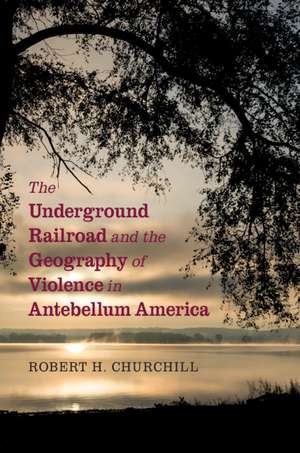The Underground Railroad and the Geography of Violence in Antebellum America
Autor Robert H. Churchillen Limba Engleză Hardback – 2020
| Toate formatele și edițiile | Preț | Express |
|---|---|---|
| Paperback (1) | 190.96 lei 3-5 săpt. | |
| Cambridge University Press – 2020 | 190.96 lei 3-5 săpt. | |
| Hardback (1) | 676.62 lei 3-5 săpt. | |
| Cambridge University Press – 2020 | 676.62 lei 3-5 săpt. |
Preț: 676.62 lei
Preț vechi: 760.24 lei
-11% Nou
Puncte Express: 1015
Preț estimativ în valută:
129.49€ • 134.83$ • 109.44£
129.49€ • 134.83$ • 109.44£
Carte disponibilă
Livrare economică 17 februarie-03 martie
Preluare comenzi: 021 569.72.76
Specificații
ISBN-13: 9781108489126
ISBN-10: 1108489125
Pagini: 266
Ilustrații: 11 maps 1 table
Dimensiuni: 156 x 235 x 20 mm
Greutate: 0.5 kg
Editura: Cambridge University Press
Colecția Cambridge University Press
Locul publicării:New York, United States
ISBN-10: 1108489125
Pagini: 266
Ilustrații: 11 maps 1 table
Dimensiuni: 156 x 235 x 20 mm
Greutate: 0.5 kg
Editura: Cambridge University Press
Colecția Cambridge University Press
Locul publicării:New York, United States
Cuprins
Part I. Origins to 1838: 1. Refugees all: the origins of the Underground Railroad; Part II. 1838–1850: 2. Under siege: borderland activists confront the violence of mastery; 3. Bondage and dignity: accommodation and collision in the contested region; 4. Free soil: Prigg, Latimer, and open resistance in the upper north; Part III. 1850–1860: 5. Law and degradation: lethal violence and beleaguered resistance in the borderland; 6. Above ground: open defiance and the limits of free soil; 7. The end of toleration: the collapse of the Fugitive Slave Act in the contested region; Epilogue: cultures of violence, secession, and war; Appendix: fugitive slave rescues, 1794–1861.
Recenzii
'Churchill's portrayal of the ways in which the distinctively Southern culture of violence alienated Northern communities subject to invasion by slave catchers is exceptionally acute. Churchill has made a lasting contribution to the history of the complex phenomenon that was the Underground Railroad, the nation's first civil rights movement.' Fergus Bordewich, author of Bound for Canaan: The Underground Railroad and the War for the Soul of America
'Original, thoroughly and comprehensively researched, well written, and tightly argued.' Steven Lubet, author of The 'Colored Hero' of Harpers Ferry
'A significant contribution to the literature on the Underground Railroad.' Graham Hodges, George Dorland Langdon, Jr Professor of History and Africana and Latin American Studies, Colgate University, New York
'Using court records, print media, and memoirs, Churchill depicts the pervasive nature of the violence that defined the relationship between fugitive slaves, bounty hunters, abolitionists, and the great many Northerners who wished no association with the culture of slavery.' S. L. Smith, Choice
'Considered together with the hundreds of individual stories of African American migrants and their interracial associates, this rich travel narrative framed by violence, intrigue, and self-determination enriches our understanding of the antebellum period.' Timothy Fritz, The Portolan
'… excellent analysis … the book demonstrates that the movement operated within a diverse 'geography of violence,' which shaped the responses of northern whites. The Underground Railroaddraws insightful connections between geographically disparate regions through the lens of cultural violence.' Oran Patrick Kennedy, American Nineteenth Century History
'Original, thoroughly and comprehensively researched, well written, and tightly argued.' Steven Lubet, author of The 'Colored Hero' of Harpers Ferry
'A significant contribution to the literature on the Underground Railroad.' Graham Hodges, George Dorland Langdon, Jr Professor of History and Africana and Latin American Studies, Colgate University, New York
'Using court records, print media, and memoirs, Churchill depicts the pervasive nature of the violence that defined the relationship between fugitive slaves, bounty hunters, abolitionists, and the great many Northerners who wished no association with the culture of slavery.' S. L. Smith, Choice
'Considered together with the hundreds of individual stories of African American migrants and their interracial associates, this rich travel narrative framed by violence, intrigue, and self-determination enriches our understanding of the antebellum period.' Timothy Fritz, The Portolan
'… excellent analysis … the book demonstrates that the movement operated within a diverse 'geography of violence,' which shaped the responses of northern whites. The Underground Railroaddraws insightful connections between geographically disparate regions through the lens of cultural violence.' Oran Patrick Kennedy, American Nineteenth Century History
Notă biografică
Descriere
A new interpretation of the Underground Railroad that places violence at the center of the story.
